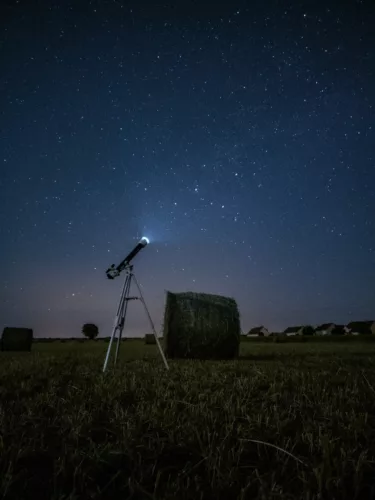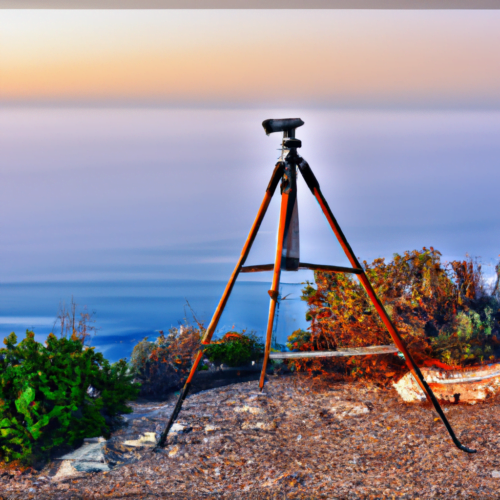So, you’re standing at a crossroads, torn between two options: a portable telescope or a stationary one. As you gaze up at the night sky, filled with wonder and curiosity, it’s natural to feel overwhelmed by the possibilities. In this article, we’ll delve into the factors you should consider when making this decision. By weighing the benefits and drawbacks of each, you’ll gain the confidence to select the perfect telescope that suits your needs and allows you to embark on a celestial journey like no other.
Table of Contents
Budget
Affordability
When considering a telescope, one of the first factors to take into account is your budget. Telescopes can vary greatly in price, with options available for a wide range of budgets. It’s important to determine how much you are willing to spend and then research telescopes within that price range. Keep in mind that more expensive telescopes often offer better image quality and additional features, but there are also affordable options that can provide a satisfying stargazing experience.
Cost of Accessories
In addition to the initial cost of the telescope itself, it’s important to consider the cost of accessories. Accessories such as eyepieces, filters, and mounts can greatly enhance your observing experience, but they can also add to the overall cost. Before making a purchase, it’s a good idea to research the availability and affordability of these accessories. Some telescopes may come with a package deal that includes essential accessories, while others may require you to purchase them separately.
Portability
Weight
Portability is an essential consideration if you plan to take your telescope on the go. The weight of the telescope can greatly impact its ease of transportation and the locations in which it can be used. Lighter telescopes are generally easier to carry and can be set up quickly, making them a great option for those who want to explore different observing sites or take their telescope on trips. However, it’s important to also consider the overall stability of the telescope, as lighter models may be more prone to vibrations.
Size
In addition to weight, the size of the telescope is another factor to consider in terms of portability. Telescopes come in various sizes, from compact ones that can fit in a backpack to larger models that require a dedicated storage space. If space is a concern for you or if you plan to transport your telescope frequently, then opting for a smaller and more compact model may be the ideal choice.
Ease of Transportation
Alongside weight and size, ease of transportation is a crucial aspect of portability. Some telescopes are designed with features such as foldable tripods or carrying cases, making it easier to transport them from one location to another. Consider the practicality of setting up and dismantling the telescope, as well as how well it can be secured during transportation, to ensure that your stargazing adventures are hassle-free.

Observing Environment
Outdoor vs. Indoor
Another factor to consider when choosing a telescope is the primary environment in which you plan to use it. Will you mainly be using your telescope outdoors or indoors? If you live in a place with clear skies and minimal light pollution, an outdoor telescope would be an ideal choice as it allows you to take advantage of the natural beauty and darkness of the night sky. On the other hand, if you are limited to observing from indoors due to certain constraints, such as urban environments with high light pollution, you might want to consider a telescope that is suitable for indoor use, such as a tabletop or computer-controlled telescope that can be easily set up by a window.
Accessibility to Dark Skies
The availability of dark skies is an important consideration for anyone interested in observing celestial objects. Dark skies, away from light pollution, offer a much clearer and more detailed view of the stars, planets, and other celestial bodies. If you live in an area with easy access to dark skies or have the means to travel to such places, choosing a telescope that can take advantage of these optimal observing conditions will greatly enhance your stargazing experience.
Light Pollution
If light pollution is a concern in your observing location, it’s important to choose a telescope that is capable of filtering out unwanted light. Light pollution can significantly impact the quality of your observations, as it diminishes the visibility of faint objects and can distort colors. Consider telescopes with light pollution filters or models specifically designed to mitigate the effects of light pollution. These features can help improve the contrast and clarity of your observations, allowing you to see more details in the night sky.
Usage
General Observations
For those who simply enjoy observing the night sky and marveling at its beauty, a telescope capable of providing clear, detailed views of celestial objects is essential. Consider telescopes with a good balance of aperture size, focal length, and image quality to ensure an enjoyable and fulfilling stargazing experience. Look for telescopes that offer a wide field of view, allowing you to take in larger areas of the sky at once. Additionally, consider the ease of use and maintenance requirements to ensure that your telescope is user-friendly and suitable for your level of expertise.
Astronomy Photography
If you have an interest in capturing stunning images of the cosmos, then a telescope suitable for astronomy photography is the way to go. Aperture size and focal length play crucial roles in determining the imaging capabilities of a telescope. Larger apertures gather more light, allowing for brighter and more detailed images, while longer focal lengths provide increased magnification. Look for telescopes with features such as camera adapters and sturdy mounts that can accommodate the weight of photography equipment. Keep in mind that astrophotography often requires additional accessories, such as tracking systems and specialized camera adaptors, which should be considered when planning your budget.
Travel Purposes
If you’re a frequent traveler or enjoy stargazing in different locations, a portable and compact telescope is a must. Consider telescopes that are specifically designed for travel, such as collapsible or tabletop models. These telescopes are often lightweight, easy to set up, and offer good image quality despite their compact size. Ensure that the telescope can be securely packed and transported, taking into account factors such as size, weight, and the availability of protective cases or bags. Having a travel-friendly telescope allows you to immerse yourself in the wonders of the universe, no matter where your adventures take you.

Optical Specifications
Aperture Size
Aperture size refers to the diameter of the telescope’s primary mirror or lens. It is a critical factor in determining the telescope’s light-gathering capability and overall image quality. Telescopes with larger apertures can gather more light, resulting in brighter and more detailed views of celestial objects. However, keep in mind that larger apertures often come with a larger price tag and increased weight. Consider your budget, portability requirements, and observing goals when deciding on the aperture size that best suits your needs.
Focal Length
The focal length of a telescope is the distance between its primary lens or mirror and the point where it converges the incoming light rays. It determines the magnification and field of view of the telescope. A longer focal length typically offers higher magnification and narrower fields of view, making it suitable for observing distant objects in greater detail. On the other hand, telescopes with shorter focal lengths provide wider fields of view, allowing you to capture larger areas of the night sky at once. Consider your observing preferences, such as whether you prioritize magnification or panoramic views, when choosing a telescope based on its focal length.
Magnification
Magnification is a key factor in determining how closely you can observe celestial objects through a telescope. It is determined by the combination of the telescope’s focal length and the eyepiece used. Higher magnification allows you to zoom in on specific details, such as the craters on the Moon or the rings of Saturn. However, it’s important to note that magnification alone does not guarantee better visibility or image quality. Factors such as atmospheric conditions and the telescope’s overall optical quality also influence what you see. Consider a telescope that allows for different eyepiece options, providing a range of magnification choices to suit your observing needs.
Image Quality
The overall image quality produced by a telescope is determined by various factors, including the telescope’s optical design, lens or mirror quality, and coating technology. Telescopes with better quality lenses or mirrors, along with advanced optical technologies, can provide sharper and clearer views of celestial objects. Look for telescopes from reputable manufacturers known for their optical expertise. Reading reviews and researching the specific model you are interested in can help you gauge the image quality it can deliver.
Mount Type
Altazimuth Mount
An altazimuth mount is the simplest and most common type of mount found in telescopes. It allows for smooth movement in both horizontal (azimuth) and vertical (altitude) directions, making it easy to navigate the night sky. Altazimuth mounts are user-friendly and suitable for casual observing. However, they do not compensate for the rotation of the Earth, which means objects may drift out of view over time. Altazimuth mounts are often found in lightweight and portable telescopes.
Equatorial Mount
An equatorial mount is designed to compensate for the Earth’s rotation and make it easier to track celestial objects. It aligns with the Earth’s axis of rotation, allowing for movement in a single axis, known as right ascension. Equatorial mounts are preferred by astronomers who engage in more advanced observing or astrophotography, as they enable precise tracking and longer exposures. However, equatorial mounts tend to be bulkier, heavier, and more complex to set up compared to altazimuth mounts.
Dobsonian Mount
A Dobsonian mount is a type of altazimuth mounting system specifically designed for large, heavy telescopes. It provides excellent stability and ease of use, making it a popular choice for amateur astronomers. Dobsonian mounts are ideal for observers who prioritize aperture size and want an affordable option that offers a good balance between image quality and portability. However, they may not come with advanced tracking features found in equatorial mounts or computerized systems.
GoTo Mount
A GoTo mount is a computerized tracking system that uses motorized controls to locate and track celestial objects automatically. It offers convenience for both casual observers and astrophotographers. With a GoTo mount, you can select an object from a database, and the telescope will automatically move to and track it. This eliminates the need for manual adjustments and allows for easy navigation of the night sky. GoTo mounts are typically found in more advanced telescopes and come with a higher price tag.

Stability
Sturdiness
Sturdiness is a crucial aspect to consider when choosing a telescope mount. A stable mount is essential for minimizing vibrations, which can greatly impact the clarity and sharpness of your observations. Telescopes mounted on unstable or lightweight tripods may be more susceptible to vibrations caused by factors like wind or accidental bumps. Look for mounts made of sturdy materials and consider the overall build quality of the telescope to ensure stable and secure observations.
Vibration
Vibrations can significantly diminish the quality of your observations, especially when using higher magnifications. Even minor vibrations can cause images to appear blurry or distorted. Opt for telescopes that have features designed to minimize vibrations, such as sturdy tripods, vibration-dampening materials, or built-in vibration suppression systems. When setting up your telescope, be mindful of your observing environment and take steps to reduce potential sources of vibrations, such as placing the telescope on a solid surface or using vibration-absorbing pads.
Ease of Use
Setup
The setup process of a telescope can range from quick and straightforward to complex and time-consuming. Consider your level of experience and how much time you are willing to dedicate to setting up your telescope each time you want to observe the night sky. Some telescopes require minimal assembly and can be ready to use within minutes, while others may involve aligning complex systems or following precise steps. Choose a telescope that matches your desired level of setup simplicity.
Alignment
Aligning a telescope is an essential step in ensuring accurate and reliable tracking of celestial objects. Some telescopes, particularly computerized models, require an alignment process to establish their reference points and enable accurate GoTo functionality. This process often involves aligning the telescope with known celestial objects or using built-in alignment features. Consider your comfort level with alignment procedures and choose a telescope with a suitable alignment method that matches your observing goals.
Control
The control system of a telescope determines how you interact with it during observations. Traditional manual telescopes rely on manual adjustments of the mount to track and observe celestial objects, allowing for more hands-on control. Computerized telescopes, on the other hand, often come with dedicated control panels or smartphone apps that enable precise GoTo functionality and tracking. Consider your personal preferences and ease of use when deciding between manual or computerized control systems.
Tracking
For those interested in observing deep-sky objects or engaging in astrophotography, accurate tracking is essential. Tracking allows the telescope to compensate for the Earth’s rotation, ensuring that celestial objects remain within the field of view for extended periods. Computerized telescopes with motorized mounts offer advanced tracking capabilities, allowing for more precise and automated tracking. Manual telescopes may require manual adjustments to track objects, which can be challenging when observing for long durations. Choose a telescope with a tracking mechanism that suits your preferences and observing goals.
Maintenance
Regular maintenance is important to keep your telescope in optimal condition for long-lasting use. Maintenance tasks can include cleaning the optics, checking and adjusting the alignment, and ensuring that all moving parts are in proper working order. Some telescopes may require more frequent or complex maintenance procedures, while others are designed for minimal upkeep. Consider your willingness and ability to perform maintenance tasks and choose a telescope that aligns with your maintenance preferences.

Power Source
Battery-operated
Many telescopes, especially portable and travel-friendly models, are powered by batteries. Battery-operated telescopes offer convenient and flexible power options, as they can be used in various locations, including those without access to mains power. Battery life and power consumption can vary depending on the telescope and accessories used. It’s important to consider the type and number of batteries required and ensure that you have an adequate supply for your observing sessions. Additionally, rechargeable battery options can be a cost-effective and environmentally friendly alternative.
Mains-powered
Some telescopes require a direct mains power connection for their operation. These telescopes often come with a power adapter that needs to be plugged into a wall socket or a portable power supply. Mains-powered telescopes provide a constant and reliable power source, which can be beneficial for extended observing sessions or when using accessories that require a consistent power supply. However, it’s important to ensure that you have access to mains power in your observing location and consider the length of power cords or the availability of extension cables if needed.
Future Upgrades
Compatibility with Accessories
Telescopes offer endless possibilities for customization and enhancement through accessories. When choosing a telescope, consider its compatibility with a wide range of accessories, such as eyepieces, filters, and cameras. Having a telescope that can easily accommodate accessories allows for future upgrades and expands the capabilities of your telescope. Research the availability and compatibility of accessories for the specific model you are interested in, ensuring that it can grow with you as your stargazing interests evolve.
Expansion Options
As your interest in astronomy grows, you may want to expand your telescope setup to include additional equipment or advanced features. Consider whether the telescope you choose offers expansion options, such as the ability to add motorized mounts, computerized control systems, or upgradeable optics. Having the potential for future expansions allows you to gradually enhance your telescope with new features and adapt it to your evolving needs and skill level.
In conclusion, choosing a telescope involves considering various factors such as budget, portability, observing environment, usage, optical specifications, mount type, stability, ease of use, power source, and future upgrade options. By thoroughly evaluating your needs, preferences, and observing goals, you can find a telescope that will provide you with years of enjoyment and wonder as you explore the depths of the universe. Happy stargazing!

